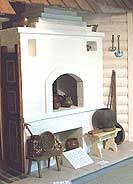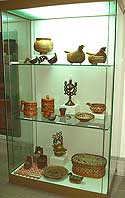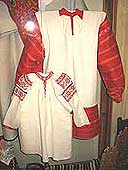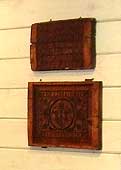The World of a Russian Village
(folk art in people’s life: rituals, traditions, feasts), (p. 2)
The first hall. Continuation
 According to the northern Russian tradition “the Russian” stove was to the right or to the left of the entrance. Near the stove there usually was a passage with a barrel or a tub for water and a hand-washer with a towel. At the stove side was a painted plank structure which was connected with the stove. The interior was plain and laconic. The earliest pieces of furniture were benches and shelves made of wide beams framed into the wall.
According to the northern Russian tradition “the Russian” stove was to the right or to the left of the entrance. Near the stove there usually was a passage with a barrel or a tub for water and a hand-washer with a towel. At the stove side was a painted plank structure which was connected with the stove. The interior was plain and laconic. The earliest pieces of furniture were benches and shelves made of wide beams framed into the wall.
 The shelves were used for tableware and various utensils. The benches were used as seats. The benches with attached seats served as beds. The interior included portable items – tables, benches, baskets. In the second half of the 19th century, there spread chests, cupboards, chairs, beds, sofas that were originally used only in chambers. The bits of furniture were often cut, sculptured or lathed and decorated with multi-colored ornamental painting.
The shelves were used for tableware and various utensils. The benches were used as seats. The benches with attached seats served as beds. The interior included portable items – tables, benches, baskets. In the second half of the 19th century, there spread chests, cupboards, chairs, beds, sofas that were originally used only in chambers. The bits of furniture were often cut, sculptured or lathed and decorated with multi-colored ornamental painting.
The second hall
 The second hall presents the exhibits connected with maternity, christening party, wedding, burial and memorial rituals and traditions of a Russian village in the late 19th – early 20th century. The specimens of folk children clothing are rare in the museum collections. The group of baby and children clothes from the Kursk and Ryazan Provinces is very valuable. It includes baby-sheets, swaddling clouts, children blanket and head-pieces for baby-sheets embroidered in golden thread from Northern Russia.
The second hall presents the exhibits connected with maternity, christening party, wedding, burial and memorial rituals and traditions of a Russian village in the late 19th – early 20th century. The specimens of folk children clothing are rare in the museum collections. The group of baby and children clothes from the Kursk and Ryazan Provinces is very valuable. It includes baby-sheets, swaddling clouts, children blanket and head-pieces for baby-sheets embroidered in golden thread from Northern Russia.
 As a rule, children in peasant families were not spoiled. Printed honey-cakes were the only dainty and desirable gifts for them. The cakes were made with the help of carved wooden blocks with recessed ornaments and flowers or figures of birds, fish and horses.
As a rule, children in peasant families were not spoiled. Printed honey-cakes were the only dainty and desirable gifts for them. The cakes were made with the help of carved wooden blocks with recessed ornaments and flowers or figures of birds, fish and horses.
|


